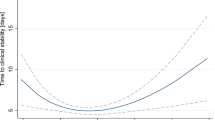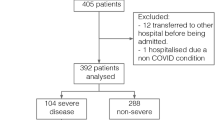Abstract
Background
The relationship between body mass index (BMI) and N-terminal pro-B-type natriuretic peptide (NT-proBNP) has not been fully investigated in patients with community-acquired pneumonia (CAP).
Methods
This prospective observational study examined 510 consecutive patients hospitalized for CAP. NT-proBNP, BMI, and the pneumonia severity index (PSI) were determined for all participants. The moderating effects of BMI on the relationship between NT-proBNP and CAP mortality were examined using interaction terms in a multivariable regression model. The ability of NT-proBNP to predict mortality was evaluated using the area under the curve (AUC).
Results
A significant inverse relationship was observed between BMI and NT-proBNP. After multivariable adjustment including BMI, NT-proBNP remained a significant predictor of CAP mortality. The AUC of the fully adjusted (including BMI) NT-proBNP model was significantly higher than that excluding BMI (p = 0.021) and that of PSI (p = 0.038), respectively. The predictive performance of NT-proBNP for mortality significantly differed by BMI group, with the NT-proBNP of the overweight and obesity group having a significantly higher AUC than that of the underweight and normal-weight group. The AUC of NT-proBNP was significantly higher and tended to be higher than that of PSI in the overweight group (p = 0.013) and the obesity group (p = 0.113), respectively.
Conclusions
BMI significantly strengthens the prognostic performance of NT-proBNP in CAP patients. The BMI–NT-proBNP interaction is significantly associated with CAP mortality, but as a prognostic determinant for CAP, NT-proBNP seems to be more useful for overweight and obese patients than for underweight and normal-weight patients.
This is a preview of subscription content, access via your institution
Access options
Subscribe to this journal
Receive 12 print issues and online access
$259.00 per year
only $21.58 per issue
Buy this article
- Purchase on Springer Link
- Instant access to full article PDF
Prices may be subject to local taxes which are calculated during checkout




Similar content being viewed by others
References
Colice GL, Morley MA, Asche C, Birnbaum HG. Treatment costs of community-acquired pneumonia in an employed population. Chest. 2004;125:2140–5. https://doi.org/10.1378/chest.125.6.2140
Fine MJ, Smith MA, Carson CA, Mutha SS, Sankey SS, Weissfeld LA, et al. Prognosis and outcomes of patients with community-acquired pneumonia: a meta-analysis. JAMA. 1996;275:134–41. https://doi.org/10.1001/jama.1996.03530260048030
Blasi F, Garau J, Medina J, Ávila M, McBride K, Ostermann H, REACH study group. Current management of patients hospitalized with community-acquired pneumonia across Europe: outcomes from REACH. Respir Res. 2013;14:44 https://doi.org/10.1186/1465-9921-14-44
Almirall J, Serra-Prat M, Bolibar I, Balasso V. Risk factors for community-acquired pneumonia in adults: a systematic review of observational studies. Respiration. 2017;94:299–311. https://doi.org/10.1159/000479089
Kuczmarski RJ, Carroll MD, Flegal KM, Troiano RP. Varying body mass index cutoff points to describe overweight prevalence among US adults: NHANES III (1988 to 1994). Obes Res. 1997;5:542–8. https://doi.org/10.1002/j.1550-8528.1997.tb00575.x
Maruyama T, Gabazza EC, Morser J, Takagi T, D’Alessandro-Gabazza C, Hirohata S, et al. Community-acquired pneumonia and nursing home-acquired pneumonia in the very elderly patients. Respir Med. 2010;104:584–92. https://doi.org/10.1016/j.rmed.2009.12.008
Murugan AT, Sharma G. Obesity and respiratory diseases. Chron Respir Dis. 2008;5:233–42. https://doi.org/10.1177/1479972308096978
Nie W, Zhang Y, Jee SH, Jung KJ, Li B, Xiu Q. Obesity survival paradox in pneumonia: a meta-analysis. BMC Med. 2014;12:61 https://doi.org/10.1186/1741-7015-12-61
Braun N, Hoess C, Kutz A, Christ-Crain M, Thomann R, Henzen C, et al. Obesity paradox in patients with community-acquired pneumonia: Is inflammation the missing link? Nutrition. 2017;33:304–10. https://doi.org/10.1016/j.nut.2016.07.016
Felder S, Braun N, Stanga Z, Kulkarni P, Faessler L, Kutz A, et al. Unraveling the link between malnutrition and adverse clinical outcomes: association of acute and chronic malnutrition measures with blood biomarkers from different pathophysiological states. Ann Nutr Metab. 2016;68:164–72. https://doi.org/10.1159/000444096
Briel M, Schuetz P, Mueller B, Young J, Schild U, Nusbaumer C, et al. Procalcitonin-guided antibiotic use vs a standard approach for acute respiratory tract infections in primary care. Arch Intern Med. 2008;168:2000–7. https://doi.org/10.1001/archinte.168.18.2000
Akpınar EE, Hoşgün D, Akpınar S, Ateş C, Baha A, Gülensoy ES, et al. Do N-terminal pro-brain natriuretic peptide levels determine the prognosis of community acquired pneumonia? J Bras Pneumol. 2019;45:e20180417 https://doi.org/10.1590/1806-3713/e20180417
Chang CL, Mills GD, Karalus NC, Jennings LC, Laing R, Murdoch DR, et al. Biomarkers of cardiac dysfunction and mortality from community-acquired pneumonia in adults. PLoS One. 2013;8:e62612 https://doi.org/10.1371/journal.pone.0062612
Nowak A, Breidthardt T, Christ-Crain M, Bingisser R, Meune C, Tanglay Y, et al. Direct comparison of three natriuretic peptides for prediction of short- and long-term mortality in patients with community-acquired pneumonia. Chest. 2012;141:974–82. https://doi.org/10.1378/chest.11-0824
Jeong KY, Kim K, Kim TY, Lee CC, Jo SO, Rhee JE, et al. Prognostic value of N-terminal pro-brain natriuretic peptide in hospitalised patients with community-acquired pneumonia. Emerg Med J. 2011;28:122–7. https://doi.org/10.1136/emj.2009.089383
Martolini D, Pistella E, Carmenini E, Santini C. NT-proBNP correlates with the illness scores pneumonia severity index and CURB-65 in patients with pneumonia. Italian. J Med. 2017;11:37–40. https://doi.org/10.4081/itjm.2017.728
Viasus D, Del Rio-Pertuz G, Simonetti AF, Garcia-Vidal C, Acosta-Reyes J, Garavito A, et al. Biomarkers for predicting short-term mortality in community-acquired pneumonia: a systematic review and meta-analysis. J Infect. 2016;72:273–82. https://doi.org/10.1016/j.jinf.2016.01.002
Yıldırım B, Biteker FS, Başaran Ö, Alataş ÖD, Acar E, Sözen H, et al. Is there a potential role for echocardiography in adult patients with CAP? Am J Emerg Med. 2015;33:1672–6. https://doi.org/10.1016/j.ajem.2015.06.036
Hall C. Essential biochemistry and physiology of (NT-pro) BNP. Eur J Heart Fail. 2004;6:257–60. https://doi.org/10.1016/j.ejheart.2003.12.015
Balion CM, Santaguida P, McKelvie R, Hill SA, McQueen MJ, Worster A, et al. Physiological, pathological, pharmacological, biochemical and hematological factors affecting BNP and NT-proBNP. Clin Biochem. 2008;41:231–9. https://doi.org/10.1016/j.clinbiochem.2007.10.005
Lewis LK, Raudsepp SD, Prickett TCR, Yandle TG, Doughty RN, Frampton CM, et al. ProBNP that is not glycosylated at threonine 71 is decreased with obesity in patients with heart failure. Clin Chem. 2019;65:1115–24. https://doi.org/10.1373/clinchem.2019.302547
Parcha V, Arora P. Glycosylation of natriuretic peptides in obese heart failure: mechanistic insights. Ann Transl Med. 2019;7:611 https://doi.org/10.21037/atm.2019.10.59
Sengenes C, Berlan M, De Glisezinski I, Lafontan M, Galitzky J. Natriuretic peptides: a new lipolytic pathway in human adipocytes. FASEB J. 2000;14:1345–51. https://doi.org/10.1096/fasebj.14.10.1345
Deng Y, Kaufman S. The influence of reproductive hormones on ANF release by rat atria. Life Sci. 1993;53:689–96. https://doi.org/10.1016/0024-3205(93)90245-x
Beleigoli AM, Diniz MF, Ribeiro AL. Natriuretic peptides: linking heart and adipose tissue in obesity and related conditions-a systematic review. Obes Rev. 2009;10:617–26. https://doi.org/10.1111/j.1467-789X.2009.00624.x
Rivera M, Cortés R, Salvador A, Bertomeu V, de Burgos FG, Payá R, et al. Obese subjects with heart failure have lower N-terminal pro-brain natriuretic peptide plasma levels irrespective of aetiology. Eur J Heart Fail. 2005;7:1168–70. https://doi.org/10.1016/j.ejheart.2005.04.003
Mickey RM, Greenland S. The impact of confounder selection criteria on effect estimation. Am J Epidemiol. 1989;129:125–37. https://doi.org/10.1093/oxfordjournals.aje.a115101
DeLong ER, DeLong DM, Clarke-Pearson DL. Comparing the areas under two or more correlated receiver operating characteristic curves: a nonparametric approach. Biometrics. 1988;44:837–45. https://doi.org/10.2307/2531595
Horwich TB, Hamilton MA, Fonarow GC. B-type natriuretic peptide levels in obese patients with advanced heart failure. J Am Coll Cardiol. 2006;47:85–90. https://doi.org/10.1016/j.jacc.2005.08.050
Bayes-Genis A, Lloyd-Jones DM, van Kimmenade RR, Lainchbury JG, Richards AM, Ordoñez-Llanos J, et al. Effect of body mass index on diagnostic and prognostic usefulness of amino-terminal pro-brain natriuretic peptide in patients with acute dyspnea. Arch Intern Med. 2007;167:400–7. https://doi.org/10.1001/archinte.167.4.400
Bahrami H, Bluemke DA, Kronmal R, Bertoni AG, Lloyd-Jones DM, Shahar E, et al. Novel metabolic risk factors for incident heart failure and their relationship with obesity: the MESA (Multi-Ethnic Study of Atherosclerosis) study. J Am Coll Cardiol. 2008;51:1775–83. https://doi.org/10.1016/j.jacc.2007.12.048
Weber M, Hamm C. Role of B-type natriuretic peptide (BNP) and NT-proBNP in clinical routine. Heart. 2006;92:843–9. https://doi.org/10.1136/hrt.2005.071233
Clerico A, Passino C, Franzini M, Emdin M. Cardiac biomarker testing in the clinical laboratory: where do we stand? general overview of the methodology with special emphasis on natriuretic peptides. Clin Chim Acta. 2015;443:17–24. https://doi.org/10.1016/j.cca.2014.06.003
Taylor JA, Christenson RH, Rao K, Jorge M, Gottlieb SS. B-type natriuretic peptide and N-terminal pro B-type natriuretic peptide are depressed in obesity despite higher left ventricular end diastolic pressures. Am Heart J. 2006;152:1071–6. https://doi.org/10.1016/j.ahj.2006.07.010
Noveanu M, Breidthardt T, Cayir S, Potocki M, Laule K, Mueller C. B-type natriuretic peptide-guided management and outcome in patients with obesity and dyspnea-results from the BASEL study. Am Heart J. 2009;158:488–95. https://doi.org/10.1016/j.ahj.2009.05.033
Januzzi JL, van Kimmenade R, Lainchbury J, Bayes-Genis A, Ordonez-Llanos J, Santalo-Bel M. The International Collaborative of NT-proBNP Study et al.NT-proBNP testing for diagnosis and short-term prognosis in acute destabilized heart failure: an international pooled analysis of 1256 patients.Eur Heart J.2006;27:330–7. https://doi.org/10.1093/eurheartj/ehi631
Kahlon S, Eurich DT, Padwal RS, Malhotra A, Minhas-Sandhu JK, Marrie TJ, et al. Obesity and outcomes in patients hospitalized with pneumonia. Clin Microbiol Infect. 2013;19:709–16. https://doi.org/10.1111/j.1469-0691.2012.04003.x
Dessì-Fulgheri P, Sarzani R, Rappelli A. Role of the natriuretic peptide system in lipogenesis/lipolysis. Nutr Metab Cardiovasc Dis. 2003;13:244–9. https://doi.org/10.1016/s0939-4753(03)80018-2
Campillo B, Paillaud E, Uzan I, Merlier I, Abdellaoui M, Perennec J, et al. Value of body mass index in the detection of severe malnutrition: influence of the pathology and changes in anthropometric parameters. Clin Nutr. 2004;23:551–9. https://doi.org/10.1016/j.clnu.2003.10.003
Tomaru KiK, Arai M, Yokoyama T, Aihara Y, Sekiguchi KiK, Tanaka T, et al. Transcriptional activation of the BNP gene by lipopolysaccharide is mediated through GATA elements in neonatal rat cardiac myocytes. J Mol Cell Cardiol. 2002;34:649–59. https://doi.org/10.1006/jmcc.2002.2005
Nikolaou NI, Goritsas C, Dede M, Paissios NP, Papavasileiou M, Rombola A, et al. Brain natriuretic peptide increases in septic shock patients without severe sepsis or shock. Eur J Intern Med. 2007;18:535–41. https://doi.org/10.1016/j.ejim.2007.01.006
Acknowledgements
The authors are grateful to all (rotating) residents and fellows of the Department of Emergency Medicine involved in the ED pneumonia registry, for assistance with collection and organization of interview and questionnaire data. Our thanks are also due to Su Jin Jeong (Kyung Hee University Medical Center, Medical Science Research Institute) for statistical advice and interpretation of analysis results.
Author information
Authors and Affiliations
Contributions
JKY: conceptualization, methodology, formal analysis, original draft, critical revision, and supervision; LJS: conceptualization, methodology, original draft, editing, and data management; KSH: conceptualization, formal analysis, original draft, review and editing; LJ: conceptualization, methodology, formal analysis, review and editing.
Corresponding author
Ethics declarations
Conflict of interest
The authors have no conflicts of interest to disclose.
Additional information
Publisher’s note Springer Nature remains neutral with regard to jurisdictional claims in published maps and institutional affiliations.
Supplementary information
Rights and permissions
About this article
Cite this article
Lee, J.S., Ko, S.H., Lee, J. et al. The relationship between body mass index and N-terminal pro-B-type natriuretic peptide in community-acquired pneumonia. Eur J Clin Nutr 75, 1088–1098 (2021). https://doi.org/10.1038/s41430-020-00817-x
Received:
Revised:
Accepted:
Published:
Issue Date:
DOI: https://doi.org/10.1038/s41430-020-00817-x
This article is cited by
-
Elevated BMI and NT-proBNP: a potential safety predictor for community acquired pneumonia discharge from the emergency department
European Journal of Clinical Nutrition (2022)



